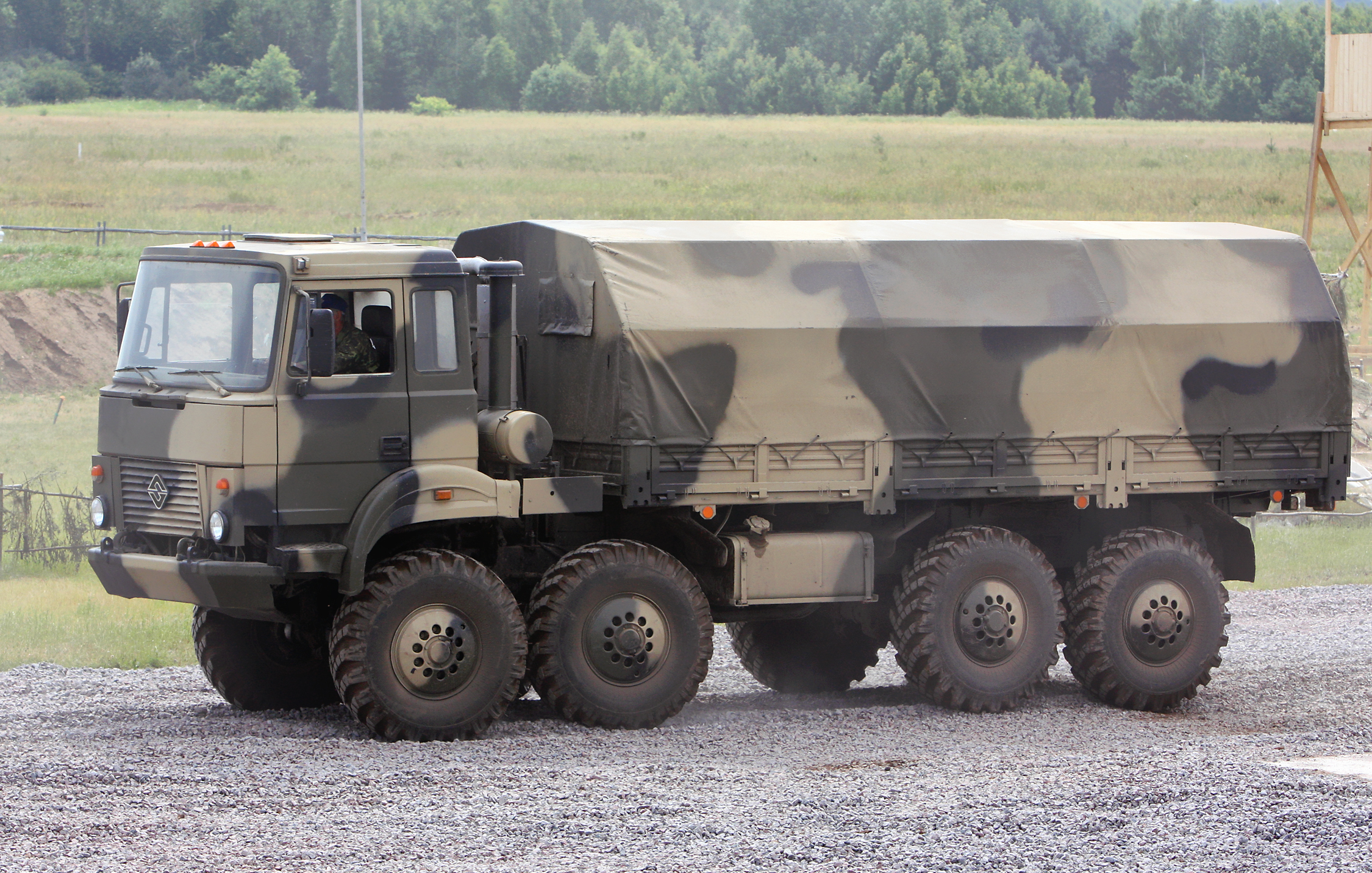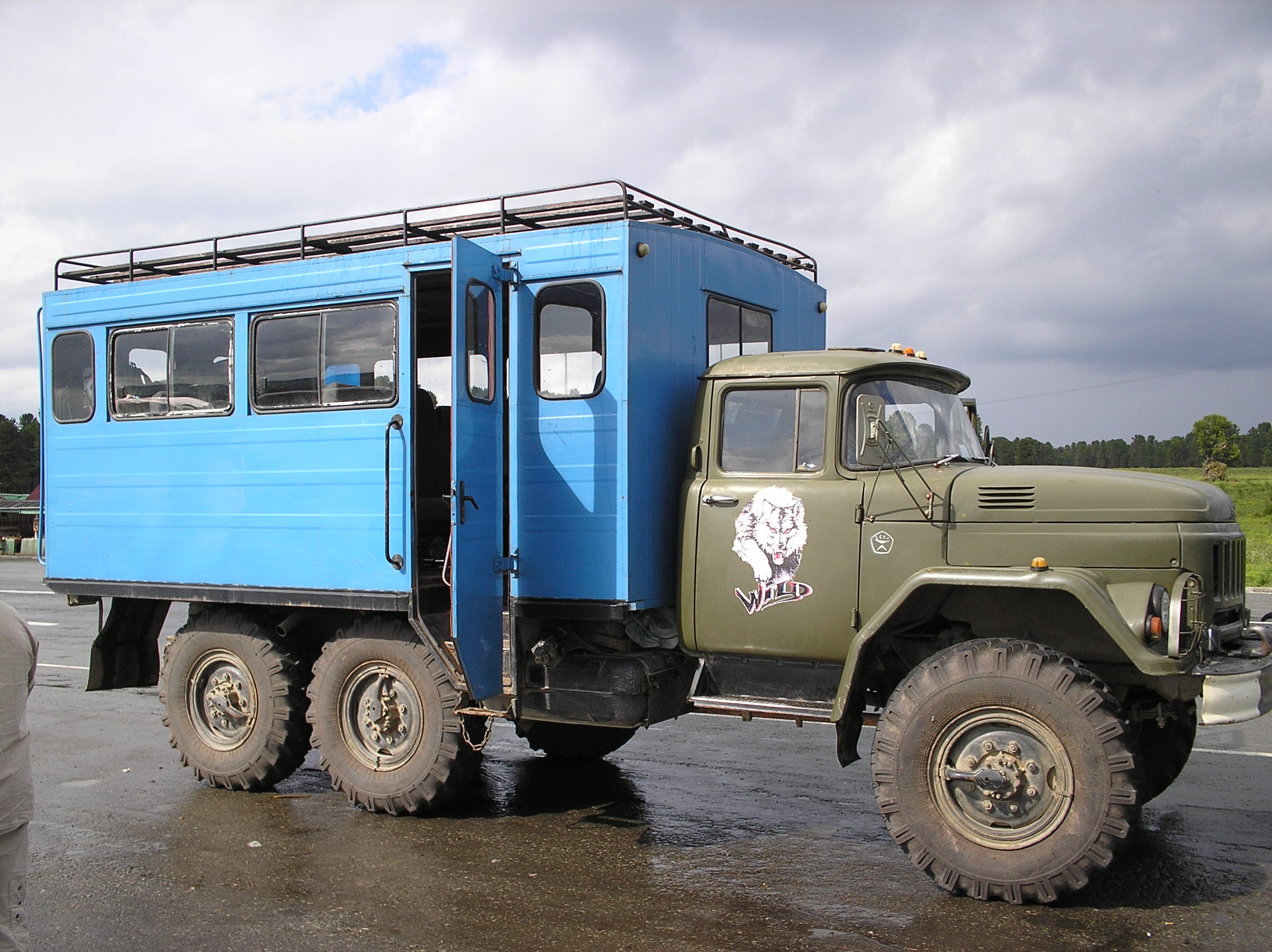|
Ural-4320
The Ural-4320 is a general purpose off-road 6×6 vehicle, produced at the Ural Automotive Plant in Miass, Russia for use in the Russian army. Introduced in 1976, it is still in production today. The wheel arrangement for the Ural-4320 was designed for transporting cargo, people and trailers on all types of roads and terrain. It also serves as a launching platform for the BM-21 "Grad" rocket launcher. __TOC__ Gallery File:Ural-4320 with headlights in bumper.jpg, Ural-4320 with headlights in bumper (civilian version since mid-1990s) File:Ural-4320 with the headlights in the wings.jpg, Ural-4320 with headlights in wings (civilian and military versions before mid-1990s and current military version) Specifications Early versions of the Ural-4320 were fitted with the KamAZ-740 V8 diesel engine, ohv, displacement 10,857 cc (bore/stroke ratio ), compression ratio 16:1. Power at 2,600 rpm. Torque at 1,500 rpm. Versions * Ural-4320-**** - ** - chassis with the standard ("cl ... [...More Info...] [...Related Items...] OR: [Wikipedia] [Google] [Baidu] |
Ural Automotive Plant
The Urals Automotive Plant, an Open Stock Company, (Russian: ''Ура́льский автомоби́льный заво́д, УралАЗ''; translit. Uralskiy Avtomobilnyi Zavod, UralAZ) is a major Russian manufacturer of off-road trucks under the Ural ( Cyrillic: "Урал") brand. Located in the city of Miass, Chelyabinsk Oblast in the Ural Mountains. The plant was established in 1941; when the ZiS truck plant was evacuated from Moscow during World War II. History Early history In the autumn of 1941, Soviet leaders decided to build a plant for the manufacturing of military trucks, and it was named Ural Automotive Plant. Since April 1942, the factory has produced primarily engines and gearboxes. On July 8, 1944 the first truck ZIS-5V was built under the brand UralZIS. The new factory became the Ural branch of ZIS UralZIS. At the End of World War II in Europe, the ZIS-5 was considered simple and robust, and thus remained in production for many years. It was not unti ... [...More Info...] [...Related Items...] OR: [Wikipedia] [Google] [Baidu] |
9K51 Grad
The BM-21 "Grad" (russian: БМ-21 "Град", lit= hail) is a self-propelled 122 mm multiple rocket launcher designed in the Soviet Union. The system and the M-21OF rocket were first developed in the early 1960s, and saw their first combat use in March 1969 during the Sino-Soviet border conflict. ''BM'' stands for ''boyevaya mashina'' ( ru , боевая машина – combat vehicle), and the nickname means "hail". The complete system with the BM-21 launch vehicle and the M-21OF rocket is designated as the M-21 field-rocket system. The complete system is more commonly known as a Grad multiple rocket launcher system. In NATO countries the system, either the complete system or the launch vehicle only, was initially known as the M1964. Several other countries have copied the Grad or have developed similar systems. In Russian service its intended replacement is the 9A52-4 Tornado. Many similar 122 mm MLRS systems are made by different countries based on the BM-21 Grad. ... [...More Info...] [...Related Items...] OR: [Wikipedia] [Google] [Baidu] |
Ural-375D
The Ural-375 is a general purpose 4.5 ton 6×6 truck, which has been produced at the Ural Automotive Plant in the Russian SFSR since 1961. The Ural-375 replaced the ZIL-157 as the standard Soviet Army truck in 1979. It was itself replaced by the Ural-4320. The Ural-375 was used, for example, as a platform for the BM-21 Grad rocket launcher, as a troop carrier, and as a supply carrier. Models The Ural-375 comes in a variety of models (the list is not exhaustive): *Ural-375, the base model. It has a canvas roof, and no steel cabin *Ural-375A, a slightly longer model *Ural-375D, the most produced 375; it has a proper all-steel cabin *Ural-375E KET-L, a recovery vehicle equipped a front-mounted and a rear-mounted winch along with a jib crane. *Ural-375S, a 6×6 tractor *Ural-377, a civilian 6×4 truck *Ural-377S, a 6×4 tractor *Ural-375DM, modernized version of the Ural-375D, built at least until 1991 [...More Info...] [...Related Items...] OR: [Wikipedia] [Google] [Baidu] |
Ural Next
Ural may refer to: *Ural (region), in Russia and Kazakhstan *Ural Mountains, in Russia and Kazakhstan *Ural (river), in Russia and Kazakhstan *Ual (tool), a mortar tool used by the Bodo people of India *Ural Federal District, in Russia *Ural economic region, in Russia *Ural Oblast (Russian Empire) (1868–1920), an administrative division of the Russian Empire and the early Russian SFSR *Ural (computer) *Ural Airlines, a Russian airline based in Yekaterinburg *Ural Automotive Plant (brand name "Ural"): **Ural-375D, a military truck manufactured by Ural Automotive Plant **Ural-4320, a military truck manufactured by Ural Automotive Plant **Ural-5323, a military truck manufactured by Ural Automotive Plant *Ural 63055 and Ural-63059, variants of Ural Typhoon, a Russian armored vehicle *Ural bomber, aircraft design program to design a long-range bomber for Luftwaffe *IMZ-Ural, a Russian motorcycle manufacturer *Murat Ural (b. 1987), Swiss soccer player *Ural (rural locality), severa ... [...More Info...] [...Related Items...] OR: [Wikipedia] [Google] [Baidu] |
Internal Troops Of Russia
The Internal Troops of the Ministry for Internal Affairs of the Russian Federation (VV; russian: Внутренние войска Министерства внутренних дел (ВВ), ''Vnutrenniye Voiska Ministerstva Vnutrennikh Del'') was a paramilitary force of the Ministry of Internal Affairs (Russia), Ministry of Internal Affairs of Russia from 1991 to 2016. The Internal Troops was a gendarmerie-like force that supported the Police of Russia, Russian police, dealt with crowd control during riots and internal conflicts, and guarded highly-important facilities such as nuclear power plants. The Internal Troops was involved in all conflicts and violent disturbances in modern Russia, including and First Chechen War, First and Second Chechen Wars, where it fell under direct military command during wartime and fulfilled missions of local defence and Rear Area, rear area security. The Internal Troops consisted of both Military volunteer, volunteers and conscripts which cau ... [...More Info...] [...Related Items...] OR: [Wikipedia] [Google] [Baidu] |
Medium Tactical Vehicle Replacement
The Medium Tactical Vehicle Replacement (MTVR) is a series of vehicles used by the U.S. Marines. The first MTVRs were delivered in late 1999. The MTVR is the equivalent of the U.S. Army’s Family of Medium Tactical Vehicles (FMTV); the Marines do not use the FMTV (with the exception of the FMTV-based HIMARS) and the Army does not use the MTVR. There were originally four, later seven, MTVR variants, then nine (plus a sub-variant) as deliveries and development continued. A dedicated trailer and prototype/developmental MTVRs have also been produced. The MTVR was designed and is manufactured by Oshkosh Defense. Development and production history The MTVR has its design origins in two U.S. military programs, the 5 ton Tactical Truck Replacement (5TTR) for the U.S. Army, and the Medium Tactical Vehicle Replacement (MTVR) for the U.S. Marines. The aim of these programs was to upgrade and extend the service life of around 3,400 U.S. Army M939 series 5 ton trucks, and 8,100 U.S. Mari ... [...More Info...] [...Related Items...] OR: [Wikipedia] [Google] [Baidu] |
Family Of Medium Tactical Vehicles
The Family of Medium Tactical Vehicles (FMTV) is a series of military vehicles that are based on a common chassis and vary by payload and mission requirements. The FMTV is derived from the Austrian Steyr 12M18 truck, but substantially modified to meet United States Army requirements, these including a minimum 50 percent U.S. content. There were originally 17 FMTV variants—four variants in the nominal 2.5 U.S. ton payload class, designated Light Medium Tactical Vehicle (LMTV), and 13 variants with a nominal 5 U.S. ton payload rating, called Medium Tactical Vehicle (MTV). Since the first FMTVs were fielded in January 1996 the family has been expanded and the overall design enhanced considerably. The FMTV was originally manufactured by Stewart & Stevenson (1996–2006), then by Armor Holdings (2006–2007), then by what is now BAE Systems Platforms & Services until 2011. It is currently manufactured by Oshkosh Corporation. Development and production history FMTV's ori ... [...More Info...] [...Related Items...] OR: [Wikipedia] [Google] [Baidu] |
Ural-5323
The Ural-5323 is an 8×8 heavy-duty off-road truck specially designed for army service. It has been produced since 1989 by the Ural Automotive Plant located in Miass, Russia. The Ural-5323 is a platform for the Pantsir-S1 gun-missile Air Defense System. The Ural-5323-20, with its 8x8 wheel configuration, is designed to carry cargo weighing up to 10 tons and tow trailers with a full weight up to 16 tons. The military version differs from the civilian version as its headlights are located on the cab. Civilian versions are sold with headlights located in the bumper. Earlier versions were equipped with cabs from Kamaz, which complicated production and were less suitable than the replacement Iveco cabs which were provided after 2000. Specifications *Units hermetization system *Remote tire pressure control. *Payload: . *Drive: 8×8. *Suspension: dependent, solid axles with leaf springs, rear - solid axles on balance-cart. rear - solid axles on balance-cart. *Engine: YaMZ-238 ... [...More Info...] [...Related Items...] OR: [Wikipedia] [Google] [Baidu] |
IVECO
IVECO, an acronym for Industrial Vehicles Corporation, is an Italian multinational transport vehicle manufacturing company. It designs and builds light, medium, and heavy commercial vehicles. The name IVECO first appeared in 1975 after a merger of Italian, French, and German brands. Its production plants are in Europe, China, Russia, Australia and Latin America and it has about 5,000 sales and service outlets in over 160 countries. The worldwide output of the company amounts to around 150,000 commercial vehicles with a turnover of about 10 billion. The company was spun-off from CNH Industrial on 1 January 2022. It is subsidiary of Iveco Group N.V., a holding company incorporated in Amsterdam, Netherlands, and is listed on Borsa Italiana. History IVECO was incorporated on 1 January 1975, with the merger of five different brands: FIAT Veicoli Industriali (with headquarters in Turin), OM (Brescia, Italy), Lancia Veicoli Speciali (Italy), Unic (France), and Magirus-Deutz (Germany ... [...More Info...] [...Related Items...] OR: [Wikipedia] [Google] [Baidu] |
Moscow Police
The Moscow Police (russian: Московская полиция), officially the Main Directorate of Internal Affairs of the City of Moscow (russian: Главное управление внутренних дел по городу Москве), is the police force for Moscow, Russia. The Moscow Police is the largest regional police force in Russia with 50,500 officers as of 2010, with primary responsibilities in law enforcement, the detection and investigation of crime, and protection of the public order in the Federal City of Moscow. It is part of the Ministry of Internal Affairs (MVD) and also subordinate to Moscow City Duma, with its headquarters located at 38 Petrovka Street in Tverskoy District, Moscow. Moscow Police is headed by the Chief appointed by the President of Russia, on the recommendation of the Minister of Internal Affairs, based on a nomination of the Mayor of Moscow. Oleg Baranov is the acting police chief who was appointed September 23, 2016. The Moscow Poli ... [...More Info...] [...Related Items...] OR: [Wikipedia] [Google] [Baidu] |
Truckbus
A combination bus, also called a truck bus or shift bus, is a purpose-built truck with a "passenger container" fulfilling the role of a bus. Such vehicles used to be common in developing countries. Alternative combination buses can be a passenger/cargo module/container mounted on a truck chassis, or a bus with a large open or closed in cargo area known as a bruck. Truck buses have been mainly used by the military, the police anti-riot units, public utilities, as school buses, and by state owned companies on short routes for employees. Construction Combination buses are built by installing a complete box body equipped for transporting people onto a truck chassis. The body is independent and separate from the driver. There is usually no passage between the cab and box body but there is usually an intercom system. The body is equipped with windows, a separate internal lighting and heating and/or air conditioning systems. Related bodies are different types of mobile workshops o ... [...More Info...] [...Related Items...] OR: [Wikipedia] [Google] [Baidu] |




